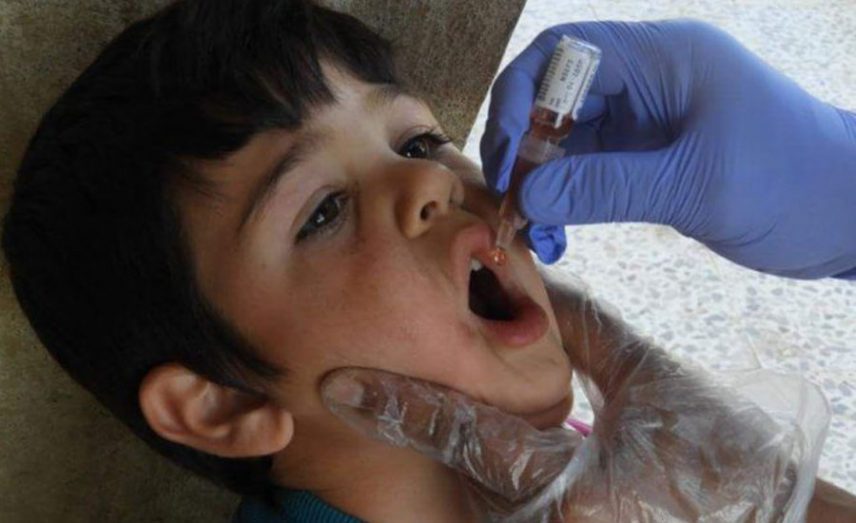More than 37,000 children in the northern Homs countryside received vaccines against polio a few days ago and are waiting to obtain the remaining important vaccines that are lacking in the area and which they need to obtain so that their lives are not in danger.
Abu Mohamed fears that his five children will fall ill in light of the bad economic and living situation. His children are in need of various vaccines which are not available today in the northern Homs countryside, which is under siege by forces of the Assad regime.
One of Abu Mohamed’s children, who is 1.5 years old, has contracted hepatitis because of the lack of necessary vaccines for the disease when he was an infant. The child went to a hospital a few days ago to be treated after specialist doctors entered the hospital.
Abu Mohamed told Sada al-Sham that his child had received nothing but the polio vaccine, explaining that the child and his siblings required several other vaccines which were not available in the besieged countryside, while it was also impossible to move the children to another area because of the siege.
Abu Mohamed left his job in the regime’s government departments in 2013 and remained in the besieged area and has not left it for government-controlled areas in the city of Homs out of fear he will be arrested and subjected to forced conscription. Therefore he lost his salary which was his sole livelihood.
The regime impedes vaccine deliveries
The Assad regime has since 2013 continued a policy of imposing a siege on the northern Homs countryside outside its control and blocking the entry of important medical materials and primary foodstuffs, while the organizations working in the area have resorted to smuggling to bring in medical supplies including vaccines.
Abu Youssef, the director of the Ansar Hospital, told Sada al-Sham that the regime had impeded the delivery of vaccines to the northern Homs countryside for years in a coordinated policy that aimed to spread diseases and epidemics among children in areas outside its control.
Abu Youssef said that the United Nations convoys that had entered the area had brought some vaccines with them but that the quantity was not sufficient for more than 10 percent of the children in the besieged countryside. He added: “The number of children who are in need of vaccines in the besieged countryside is more than 13,000.”
The children are in need of a number of vaccines, most importantly those against tuberculosis, hepatitis, oral polio, muscular polio, peptic ulcer, and measles. Children from the ages of 1 day to 5 years take these vaccines.
Abu Youssef said that a vaccinations room in the northern Homs countryside was working to secure oral polio vaccines for all the children in the countryside, but that there was a shortage in the other vaccines, which has led to an outbreak of hepatitis in some areas, in some cases leading to the children’s deaths.
Yahya, a doctor and director of the Homs vaccinations room who is in charge of the vaccination campaigns underway in the northern countryside, said that the Homs vaccinations room had launched a new campaign against child polio and that the vaccines were coming from UNICEF under the supervision of the Qatar Red Crescent.
The campaign which Yahya was discussing is targeting 37,300 children spread throughout three sectors — Rastan, Houla and Talbeesa. Roving teams are deploying in these sectors as follows: 30 teams in the Rastan sector, 29 in the Talbeesa sector and 18 in the Houla sector.
These teams are offering vaccines which are given at two points in the child’s mouth from the age of 1 day to 5 years. This campaign should cover all areas of the northern Homs countryside within four days.
The northern Homs countryside was among the first areas to rise up against the Assad regime and is the last stronghold of the Syrian revolution in Homs province. It contains over 300,000 civilians, including residents and displaced people. Many suffer from living hardships in light of the siege imposed on the region.
The countryside has seen relative calm since it entered the de-escalation zones agreement with the Russians, who are patrons of the Assad regime. The calm has been permeated by sporadic bombardment by regime forces, which has led to casualties among civilians, while negotiation rounds have been held between an opposition committee and the Russians.
The regime is trying, according to opposition sources in the area, to evict the residents and armed opposition groups and the Free Syrian Army through threats of a military operation, if the conditions which the regime has set during the negotiations are not met.
This article was translated and edited by The Syrian Observer. Responsibility for the information and views set out in this article lies entirely with the author.


